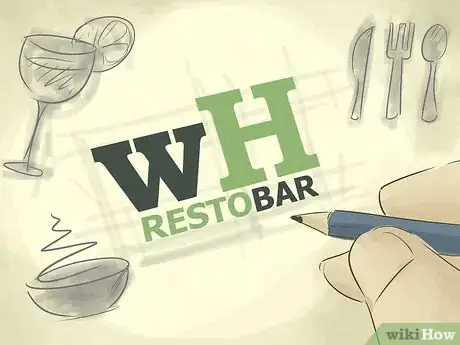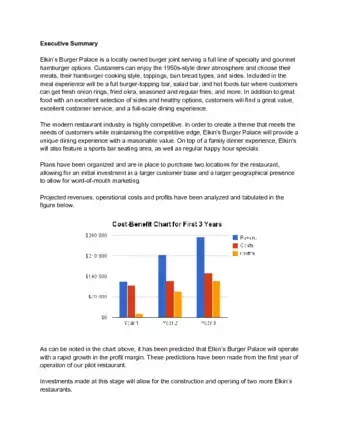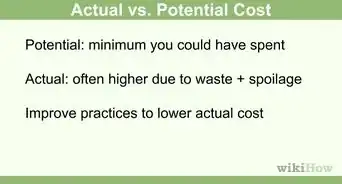This article was co-authored by Alex Hong. Alex Hong is the Executive Chef and Co-Owner of Sorrel, a New American restaurant in San Francisco. He has been working in restaurants for over ten years. Alex is a graduate of the Culinary Institute of America, and has worked in the kitchens of Jean-Georges and Quince, both Michelin-starred restaurants.
wikiHow marks an article as reader-approved once it receives enough positive feedback. This article received 20 testimonials and 99% of readers who voted found it helpful, earning it our reader-approved status.
This article has been viewed 667,518 times.
Opening a new restaurant can be a risky business venture, but with the right planning, financing and plenty of hard work it's definitely doable. Owning a successful restaurant could be one of the most exciting and rewarding experiences of your life. So what are you waiting for?
Steps
Devising a Plan
-
1Determine a food concept. A food concept is the first thing to consider when planning on opening a restaurant. Are you aiming for a family-style steakhouse, upscale French cuisine or a quick-service ethnic restaurant? Having a food concept will give your potential customers some idea of what they can expect from your restaurant. Determining a food concept from the get-go will also help you to structure and organize other aspects of your business.
- Some potential food concepts include: seafood, steakhouse, family-style restaurant, casual-dining restaurant, ethnic restaurant, pizzeria, sandwich shop, coffeehouse, bakery.
- Once you have decided on a food concept, you can begin crafting your menu. Don't worry about pricing or exact recipes to begin with, just try to get a sense of how your menu can best reflect your chosen food concept. Some things to consider when planning a menu include: what potential competitors are offering, where you will source the required ingredients, special equipment or layout requirements for the preparation of menu items and whether any special personnel skills will be required.
-
2Consider the ambiance. The ambiance or atmosphere of the restaurant is another important factor, relating to the food concept. Many varied factors contribute to the ambiance of a restaurant, such as furniture, lighting, dish and glassware, servers' uniforms, music, serving style and clientele. Having an idea of the ambiance you wish to create is important as it will help to guide you during the decision-making process. Always keep an image of what you aim to achieve in mind.Advertisement
-
3Plan on a serving style. Your food concept, target customers and location will all play a role in deciding on a service style. There are three main service styles: quick-service, mid-scale and upscale. It is important to decide which category your restaurant falls in to, as this distinction will help shape future decisions, such as staffing requirements and pricing.
- Quick-service restaurants, or fast-food restaurants, are known for their low-cost menus and quick preparation. Examples include burger joints, pizza restaurants and ethnic foods.
- Mid-scale restaurants fall halfway between fast-food and upscale restaurants. They offer full service and good value menus. Some mid-scale restaurants include buffets and salad bars.
- Upscale restaurants pride themselves on providing excellent food and high quality service. Fine-dining establishments are the fanciest type of restaurant available - they offer the best quality food at the highest prices.[1]
-
4Research the cost. It is imperative that you are fully aware of how much your new business venture is going to cost. Do your homework. Talk to other restaurant and local business owners. Find out about rent, insurance and permit costs. The more information you have, the more financially prepared you can be.
-
5Craft a business plan. A comprehensive, accurate business plan is the most critical component of opening a new restaurant. In fact, the success or failure of your restaurant can hinge on the strength of your business plan, so make sure to do it right. When you're writing a business plan you should include:
- A comprehensive description of your concept.
- A description of your target customers.
- An outline of your menu and potential pricing.
- As much financial information as possible. Include details on your start-up capital (how much money you have and where its coming from), as well an estimate of your long-term income and expenditure.
- Information on how you plan to market your restaurant.
- Details of your plan to hire and train employees, as well as an outline of any employee retention programs.
- You should also include a section which addresses how you plan to cope with the pressures and problems that you, as a restaurateur, will have to face on a daily basis. Working out a possible exit strategy in your business plan may also be helpful.[1]
Taking Care of Legal Aspects
-
1Choose a location with proper zoning. It is vital that you research local zoning ordinances and regulations before deciding on a location for your restaurant. Zoning ordinances deem that a commercial property, such as a restaurant, cannot be located in a residential zone. Therefore, you should contact the town manager to find out if your potential property is properly zoned for a restaurant, before contacting the landlord about lease options.
- Zoning laws also regulate how you intend to use the space within your property, along with any renovations or improvements you plan on making, so it is important to understand all of the ins-and-outs of the zoning laws regarding that specific property before you commit to a lease.[2]
- If you intend on having a bar in your restaurant, be sure to ask about serving alcohol in that particular area as well. Some towns prohibit the sale of alcohol in certain zones.[3]
-
2Clean the place up according to federal, state and local safety laws. Once you’ve determined the location to be in the proper zone for a restaurant, you need to know how safe it is. A local building inspector or code enforcement officer can walk you through all the safety requirements needed to pass a building inspection. Along with a fire suppression system in the kitchen, the building may require an entire sprinkler system. The code enforcement officer will also look at the general safety of building to decide if it is fit to operate as a restaurant.[4]
-
3Register your business. A business licence is required by all restaurants. It essentially grants you the permission to open your doors for business. Generally, business licences are issued by the city or local municipality.
- Go to the city or county office to apply for the business license. There you will be required to complete an application and pay a licensing fee.
- You should also contact your state's department of revenue to determine if you are required to register your business with the state.
-
4Take care of any licences and permits. You must obtain certain permits and licenses before opening the doors of your restaurant, including a health permit, a liquor licence and a music copyright licence.
- Most health permits will only be granted after the restaurant passes a health inspection. Therefore, it is important to understand the local requirements early in the process to ensure that any planned kitchen or dining room configuration will be in accordance with the local health department rules.
- If a restaurant plans to play live or recorded music (including music played on a iPod), it must obtain a copyright license from the appropriate music licensing agency. The two primary agencies are the American Society of Composers, Authors & Publishers (ASCAP) and Broadcast Music, Inc. (BMI).
- Your local restaurant association can often provide information about required permits and licenses.
-
5Invite the health inspector over. Before a new restaurant opens, it must pass an initial health inspection. To arrange a health inspections, contact your local health department at least 30 days prior to opening. During this visit, the health inspector will most likely focus on your equipment and food storage.
- The health inspector may check to make sure your walk-in cooler is reading the correct temperature and make sure your establishment has enough hand sinks located in the correct places.
- The health inspector will also check to make sure you have your food service operator’s license and any other documentation the health code requires.
Securing Funding
-
1Look at your own resources. Take a good look at the assets you have at your disposal, you probably have more than you realize. Consider your savings and retirement accounts, any equity you might have in real estate, valuable vehicles or other belongings, along with any other investments you've previously made. It may be possible to sell these assets, or you can use them as loan collateral. You should also have a discussion with your bank about your credit line - they may be able to offer you enough credit to get your restaurant up and running.[1]
-
2Ask for business loans from the bank. Commercial bank loans are the most common form of start-up funding for aspiring businesses. However, securing a loan from a bank as a first-time restaurant owner has its challenges:
- Inherent risk factor. Commercial banks typically find start-up restaurants extremely risky to finance, since more than 25% of new restaurants fail within the first year of opening. Bank loans are risky for restaurant owners as well. If the restaurant business does go under, the owner is still responsible for repaying the loan.
- Bias against first-time owners. Lenders examine restaurant loan applications closely, and first-time owners usually confront skeptical lenders when presenting their business plans. For subsequent openings, the process becomes much easier. Lending institutions prefer applicants who can submit evidence of successful past performance.
- Probability of rejection. Many restaurant owners are rejected for loans the first time. Do not be afraid to try again at a different bank. With every attempt, refine your argument and perfect your business plan. It may take a while, but perseverance will usually reward you with the loan you need.[5]
-
3Ask friends and family for help. Once you have taken account of all of your personal resources, you can consider turning to supportive friends and family members for financial support. Just be wary that borrowing money from those closest to you can result in complicated situations. Make sure to treat this as a business arrangement and to set its terms out in writing. Confirm that your friend or relative is aware of the risks involved in investing in a start-up restaurant.[1]
-
4Partner up. Finding a business partner can be a great way to get the start-up capital you need, while also finding someone to share in the responsibilities involved in opening a restaurant. Alternatively, you may find someone who would like to invest in your business, but wants no involvement in the day-to-day running of a restaurant. Either way, you should make sure that you outline each partner's individual roles and responsibilities in a written partnership agreement. That way everything should remain transparent and above board. Also be sure to choose your partners carefully--especially when it comes to family members.[1]
-
5Take advantage of government programs. There are numerous local, state and federal programs which exist solely to provide financial support for small businesses. Do your research and find out if your new business qualifies - you may be pleasantly surprised by the resources available to you. Check out the SBA, read the literature on small businesses at your local library and be sure to find out about special business incentives for veterans, and minorities.[1]
Gathering Supplies
-
1Contact food service vendors. Reliable food service distributors play an important role in the success of your business and you will want to choose a distributor who provides good quality products with prompt, consistent delivery.
- You can find food service vendors online, in the Yellow Pages or by attending restaurant conferences or trade shows.
- Ask other restaurants in your area who they get their products from. Ask which suppliers they like in particular and why.
-
2Get in touch with local producers. Restaurants using high-quality, locally-sourced ingredients are becoming increasingly popular. Approach local farmers and food manufacturers about buying food in bulk. Farmers can supply your restaurant with produce by the bushel, as well as fresh meat and dairy products. A local manufacturer, such as a bakery, can supply large quantities of breads, rolls and other baked goods.
-
3Shop around. Make sure to shop around before signing any agreements with food suppliers. Getting a good deal does not necessarily mean choosing the supplier with the lowest price. The quality of the food and service provided are just as important.
- Look for references and contact other restaurants the supplier has worked with.
- Negotiate the details of food specifications, delivery times and terms of payment. Choosing a vendor with whom you can forge a good working relationship will be helpful in the long run.
-
4Hire employees. A well-trained and professional staff is essential to the success of any restaurant. Before hiring, decide how many employees you will need, what the job description for each position will be and what the pay scale will be. Take the time to thoroughly interview each applicant. You also need to ensure that they are aware of exactly what their role will be within the restaurant, and what you expect of them. You will need to hire:
- A manager. Choosing a manager for your restaurant is one of the most important decisions you will have to make. A good manager will have a wealth of experience (hopefully managing a similar type of restaurant), excellent leadership skills, and an in-depth knowledge of the ins and outs of running a successful business. They should also share a similar value system to you and be enthusiastic about embodying the style and character of your restaurant.[1]
- Cooks. A restaurant is nothing without great food, so getting your hands on some excellent cooks should be a top priority. Local cooking schools can help point you in the right direction, and placing the ad in the paper can yield promising results. Depending on the size of your restaurant, you'll probably need at least three cooks to begin with, one of whom will be part time. When hiring cooks, besides producing great-tasting food, you are looking for consistency and attention to detail.[1]
- Servers. Servers will have the most interaction with your customers, so you will need to hire friendly, capable people who can multi-task and work well under pressure. You will need to train any new servers, whether they have experience or not, to reflect the serving style of your particular restaurant.[1]
- To determine how many employees you will need, consider how many tables, seats and service stations you will have. Think about what your busiest hours will be and ensure they will be adequately staffed. You will also need to consider your budget, this will influence how many employees you can afford to hire and at what rate of pay.
Attracting Customers
-
1Know your target market. Be aware that it is impossible to appeal to 100% of the market. You cannot satisfy everyone. With this in mind, focus on your target market. Identify what their needs are and do your best to meet those needs. Some examples of target markets are:
- Teens, students and young adults. This is a large and ethnically diverse market. Fast-food or quick-service restaurants are popular with this market.
- Families with children. Good value and a child friendly atmosphere are important here. Menus should cater to both adults and children.
- Empty nesters. Empty nesters consist of people aged between 50 and 65 with grown children who no longer live at home. This group tends to have a higher income and typically visits upscale restaurants. They are less concerned with price and are more focused on excellent service and outstanding food. Appeal to this group with elegant surroundings and a sophisticated ambiance.[1]
- Vegetarians. Restaurants catering specifically for vegetarian and vegan customers are becoming more and more popular.
-
2Plan your grand opening. A grand opening is the best time to get press for your restaurant. Although it can be costly, the money you spend on your grand opening will be worth it if your restaurant gets publicity. A successful grand opening takes time and planning, so choose the date well in advance and consider hiring a local publicist to help with the advertising. Here are some ideas to help make your grand opening a success:
- Hire photographers. Make sure there is someone there to photograph your grand opening. That way, there will be pictures ready for any journalists looking to cover it. Keep in mind that the press that comes after your grand opening is just as important as the press that informs the public of your opening. Do not let up on your public relations efforts just because your grand opening is over.
- Invite a reviewer. If you know that your food is top notch, you will want to invite a food critic or restaurant reviewer to your grand opening. This is sure to get you some press, although there is a risk that the press might be negative.
- Invite a local celebrity. If you get a local politician, television host or any other local celebrity to come to your grand opening, you will be more likely to get some media coverage.
- Provide entertainment. By providing your customers with an enticing form of entertainment – such as a live band, DJ, dancing or contests – you will create a night that they will remember.
-
3Place traditional ads. Contact local newspapers, magazines and broadcasting stations to see if they would be willing to cover a story about your restaurant and its upcoming grand opening. You could also write an editorial or an opinion article about why the community needs a restaurant like yours.
-
4Offer incentives using social media. Facebook, Twitter, Foursquare, Yelp and other social media sites are this generation’s means of word of mouth marketing. Promote social media activity that promotes your restaurant by offering various incentives such as:
- Free drinks for checking in to Foursquare while at the restaurant.
- Receive 10% off your next bill with a Yelp Review.
- Dessert thrown in with any entrée order with a location update in Facebook.
-
5Create a logo that can catch on. The right restaurant logo can get customers' mouths watering before they even see the menu. Create a unique and eye-catching logo which your customers will come to associate with great food and top-notch service.
Keeping the Gears Going
-
1Keep up to date on legal matters. It is important to keep on top of all legal matters in the restaurant business. Failure to have the correct permits or licences can result in heavy penalties, including fines and restaurant closure.
-
2Mind the books. The key to any successful business is simple: profits. Restaurant businesses need to make money to survive, and in order to make money, restaurant owners, operators and managers need to know basic restaurant accounting systems to control cash flow, reduce losses and maximize their profits. Keeping track of your finances will put you in a good place to monitor your cash flow and make the most of your business in the long run.[6]
-
3Listen to employee and customer feedback. In the restaurant business there is always room to improve. Listening to both customer and employee feedback is a great way to figure out what you're doing right and what you could do better.
- Make sure your waiters are asking customers whether they enjoyed their meal – this isn’t just good for feedback, it’s good customer service.
- Sites like tripadvisor.com are very useful when it comes to monitoring customer opinion. Don't be afraid of negative reviews, see what you can learn from them and move on.
- Listening to employee feedback can help to create a better workplace for everybody. Happy employees lead to higher productivity, lower turnover of staff and satisfied customers!
Sample Business Plan and Vendor Letter
Expert Q&A
-
QuestionWhat should I know before opening a restaurant?
 Alex HongAlex Hong is the Executive Chef and Co-Owner of Sorrel, a New American restaurant in San Francisco. He has been working in restaurants for over ten years. Alex is a graduate of the Culinary Institute of America, and has worked in the kitchens of Jean-Georges and Quince, both Michelin-starred restaurants.
Alex HongAlex Hong is the Executive Chef and Co-Owner of Sorrel, a New American restaurant in San Francisco. He has been working in restaurants for over ten years. Alex is a graduate of the Culinary Institute of America, and has worked in the kitchens of Jean-Georges and Quince, both Michelin-starred restaurants.
Executive Chef & Restaurant Owner Opening a restaurant takes money and you have to find the perfect location. It probably took us 2 years to find the right spot for Sorrel. Then, you need a super talented team. If you want to work with a partner, you have to find someone you can work closely with, and you need people for the front and the back of the house who really want to work there.
Opening a restaurant takes money and you have to find the perfect location. It probably took us 2 years to find the right spot for Sorrel. Then, you need a super talented team. If you want to work with a partner, you have to find someone you can work closely with, and you need people for the front and the back of the house who really want to work there. -
QuestionWhat questions should I ask customers for feedback?
 Community AnswerSome things along the lines of: "Was it good value for money?"; "Were you happy with the menu options?"; "Did you like the waiters/waitresses?"; "Is there anything that could've improved your experience?"
Community AnswerSome things along the lines of: "Was it good value for money?"; "Were you happy with the menu options?"; "Did you like the waiters/waitresses?"; "Is there anything that could've improved your experience?" -
QuestionHow do I know what to buy for my restaurant's kitchen?
 Community AnswerIt all depends on the kind of food you would want to serve. The few things all kitchens need are: a sink, some kind of refrigeration, and a freezer. Depending on what you are cooking, you may also need an oven, a deep fryer, a stove, a grill, etc.
Community AnswerIt all depends on the kind of food you would want to serve. The few things all kitchens need are: a sink, some kind of refrigeration, and a freezer. Depending on what you are cooking, you may also need an oven, a deep fryer, a stove, a grill, etc.
Warnings
- Many restaurants fail within their first two years of opening. Starting a restaurant can be fun, exciting, and rewarding, but it's also a whole lot of work and can be risky.⧼thumbs_response⧽
References
- ↑ 1.01.11.21.31.41.51.61.71.81.9http://www.entrepreneur.com/article/73384-2
- ↑ http://www.sba.gov/content/basic-zoning-laws
- ↑ http://restaurants.about.com/od/location/bb/Location.htm
- ↑ http://restaurants.about.com/od/location/bb/Location.htm
- ↑ http://www.foodservicewarehouse.com/restaurant-equipment-supply-marketing-articles/how-to-start-a-restaurant/funding-your-new-restaurant/c28287.aspx
- ↑ http://www.foodservicewarehouse.com/restaurant-equipment-supply-marketing-articles/restaurant-management-and-operations/basic-restaurant-accounting-/c28014.aspx
About This Article
To open a restaurant, first decide on a food concept and the type of atmosphere you’d like to create. For example, do you want an upscale pizzeria or a hip coffeehouse? Once you have a basic vision, craft a business plan that includes a description of your target customers, potential pricing, start-up costs, and employee needs. As your plan turns to a reality, find a location with the proper zoning for commercial properties. Finally, contact food suppliers and local farmers to get the best ingredients. For tips on how to attract customers, keep reading!





























-Step-7-Version-3.webp)





















-Step-7-Version-3.webp)






































